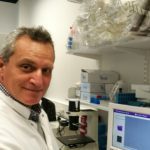Link to Pubmed [PMID] – 18635866
Stem Cells 2008 Oct;26(10):2564-75
Stem cell-based therapies hold therapeutic promise for degenerative motor neuron diseases, such as amyotrophic lateral sclerosis, and for spinal cord injury. Fetal neural progenitors present less risk of tumor formation than embryonic stem cells but inefficiently differentiate into motor neurons, in line with their low expression of motor neuron-specific transcription factors and poor response to soluble external factors. To overcome this limitation, we genetically engineered fetal rat spinal cord neurospheres to express the transcription factors HB9, Nkx6.1, and Neurogenin2. Enforced expression of the three factors rendered neural precursors responsive to Sonic hedgehog and retinoic acid and directed their differentiation into cholinergic motor neurons that projected axons and formed contacts with cocultured myotubes. When transplanted in the injured adult rat spinal cord, a model of acute motor neuron degeneration, the engineered precursors transiently proliferated, colonized the ventral horn, expressed motor neuron-specific differentiation markers, and projected cholinergic axons in the ventral root. We conclude that genetic engineering can drive the differentiation of fetal neural precursors into motor neurons that efficiently engraft in the spinal cord. The strategy thus holds promise for cell replacement in motor neuron and related diseases. Disclosure of potential conflicts of interest is found at the end of this article.


